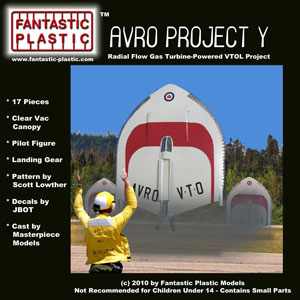Avro Project Y (1952)
About the Design
In the early 1950s, U.S. and Canadian defense officials were extremely concerned with Soviet advances in long-range, high-altitude bomber technology. They saw a pressing need for a high-altitude, high-speed interceptor that could, if necessary, operate out non-conventional airfields to protect North America from enemy incursion.
In 1952, the Canadian Defense Research Board hired Avro-Canada, the Canadian branch of England's A.V. Roe & Co., to develop an interceptor to meet the Soviet threat. Avro's response was this radically shaped single-pilot aircraft to be powered by an experimental RFGT (RadIal Flow Gas Turbine) engine, a cutting-edge concept that promised to deliver far more thrust more efficiently than any conventional jet engine at the time. (RFGT technology is believed to have been developed by the Germans during WWII, but there is no evidence it has ever been installed on an actual aircraft.) Preliminary studies indicated the Project Y, aka, "The Spade," aka, "The Ace," aka, "The Manta," would have a top speed of Mach 2.5, an operating ceiling of 65,000 feet, and a range of 1,000 miles. By late 1952, a Project Y mock-up at already been built (photo above), but soon thereafter the project was cancelled for reasons that still remain somewhat unclear. _
|
About the Kit
The first scale model of the Avro Project Y ever produced, this kit was released by Fantastic Plastic Models in June 2010. Designed in CAD by Scott Lowther, it was cast by Masterpiece Models. The kit featured a seated pilot figure, vacuform canopy and landing gear.
This kit was built from an original issue. |



